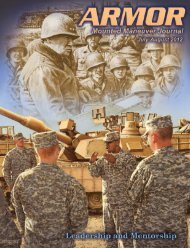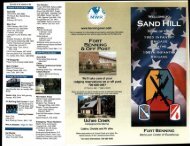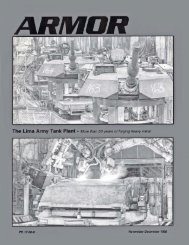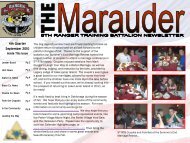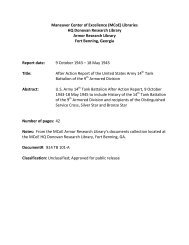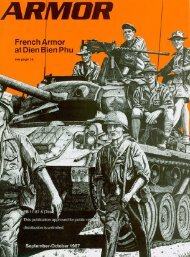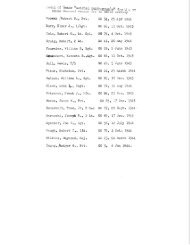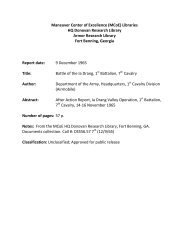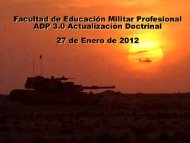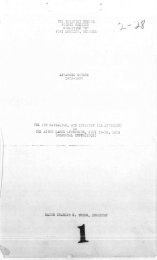- Page 1 and 2:
(h Medal of Honor "awarded posthumo
- Page 3 and 4:
Distinguished Serrice Cross Awards
- Page 5 and 6:
e GENERAL Onoms NO. 1 1No~s.-Genera
- Page 7 and 8:
States Army Forces in the Far East,
- Page 9 and 10:
GENEEAL Onnms No. 2 WAR DEPARTNENT
- Page 11 and 12:
stnnding services during the pcriod
- Page 13 and 14:
President d the United States as pu
- Page 15 and 16:
sliite of the almost continuous dis
- Page 17 and 18:
GENEB~ O~UWS WAR DEPARTNENT No. 4 }
- Page 19 and 20:
Brigadier General Rayhond A. Helser
- Page 21 and 22:
VILLEGION OF MERIT.-1. By direction
- Page 23 and 24:
of America Typhus Commission, durin
- Page 25 and 26:
Gs~aaar OaoE~s NO. 5 WAR DEPARTMENT
- Page 27 and 28:
Technical Sergeant Donald Garson Sc
- Page 29 and 30:
WAR DEPARTAiENT No. 6 W~sar~cm~ 26,
- Page 32 and 33:
this high standard of combat readin
- Page 34:
Brigadier General Frank F. Ewereat,
- Page 37 and 38:
WAX DEPARTMENT WAGHIKCTOR 25, D. C.
- Page 39 and 40:
2. By direction of the President, u
- Page 41 and 42:
6, By direction of the President, i
- Page 44 and 45:
XILRATTLE HONORS.-As authorized by
- Page 46 and 47:
three-day stand in the face of terr
- Page 48 and 49:
Lieuteuant Colonel F~ederiok M. Bro
- Page 50 and 51:
Brigadier Kenneth a. Melean, C B, B
- Page 52:
Commission, including tbe control o
- Page 55 and 56:
ing ready to advance in less than ;
- Page 57 and 58:
artillery, machinegun, and smnll~ar
- Page 59 and 60:
enemy; but when the enemy discovere
- Page 61 and 62:
' long and hazardous drive from the
- Page 64 and 65:
GO 11 12 operations eflcicncy at a
- Page 66 and 67:
causing extenslve damage and destru
- Page 68 and 69:
of the Intelligence and Rrcmnoissan
- Page 70 and 71:
2d Obsermtion Squadron. 15th Chemic
- Page 72 and 73:
90th Bombardment Group (Heavy), Hea
- Page 74 and 75:
IILBURIMA, 1942.-1. Announcement is
- Page 76 and 77:
1011th Signal Company Service Group
- Page 78 and 79:
12th Air Cargo Resupply Squadron. 1
- Page 80 and 81:
78th Quartermaster Battalion (Mobil
- Page 82 and 83:
393d Engineers (Special Service Reg
- Page 84 and 85:
831st Signal Bnttnlion (Special), C
- Page 86 and 87:
36491:h Quartcrmaster Truck Company
- Page 88 and 89:
10th Radar Callhration Detachment.
- Page 90 and 91:
VIIILCHINA DEFENSIVE.-1. Announceme
- Page 92 and 93:
53d Portable Surgical Hosgital. 54t
- Page 94 and 95:
GO 12 26 Aorm 241, this general ord
- Page 96 and 97:
374th Quartermaster Truck Compang (
- Page 98:
26th Bombardment Sqnadron (Heavy),
- Page 101 and 102:
6th Replacement Depot, Headquarters
- Page 103 and 104:
21st Quartermaster Truck Battalion
- Page 105 and 106:
I 48th Qunrtermaeter Group, Readuua
- Page 107 and 108:
95th Ordnance Battalion, Headquar-
- Page 109 and 110:
156th Finance Disbursing Seetlon. 1
- Page 111 and 112:
i 204th Galaria Survey Uuit mm.) .
- Page 113 and 114:
275th Port Company, Transportation
- Page 115 and 116:
SGOth Quartermaster Company (Cam. p
- Page 117 and 118:
459th Counter Intelligence Corps De
- Page 119 and 120:
570th Engineer Dump Truck Company 5
- Page 121 and 122:
716th Tank Battalion. 17741h Engine
- Page 123 and 124:
029th Army Postal Unit. 929th Engin
- Page 125 and 126:
1412th Quartermaster Depot Company.
- Page 127 and 128:
1884th Qualtermaster Tmck Company (
- Page 129 and 130:
3683d Signal Service Oetachment 333
- Page 131 and 132:
5280th Ordnance Battalion (Aviation
- Page 133 and 134:
7th Tactical AIr Oommnnications 1 2
- Page 135 and 136:
Mist Signal Photogrsphic Company. L
- Page 137 and 138:
2. When entering individual credit
- Page 139 and 140:
BIXMARCK ARCHIPBLACO 1st Cavalry Di
- Page 141 and 142:
Mth Army Postal Unit (Type F). 1318
- Page 143 and 144:
620th Amphibian Truck Company, 1461
- Page 145 and 146:
4th Aircraft Repair Unit (Floating)
- Page 147 and 148:
55th Reconnxissanco Squadron, 77th
- Page 150 and 151:
GO 12 459th - Aviation ~ ~ Sauadron
- Page 152 and 153:
7626 Antiaircraft Artillery Gun Bat
- Page 154 and 155:
S116th Signal Service Battalion (tw
- Page 156 and 157:
1st Portable Surgical Hospital. 1st
- Page 158 and 159:
14th Replacement Battalion, Headqua
- Page 160 and 161:
56th Malaria Control Detachment. '
- Page 162:
145th Field Artillely Battalion (15
- Page 165 and 166:
97 GO 12 801st Quartermaster Railhe
- Page 167 and 168:
420th meld Artillery Group, Headqua
- Page 169 and 170:
6Olst Quartermaster Grave Registrat
- Page 171 and 172:
103 893d Medical Clearing Company.
- Page 173 and 174:
105 GO 12 1715th Signal Service Bat
- Page 175 and 176:
19818th Quartermaster Gasoline Supp
- Page 177 and 178:
United States Army Services of Supp
- Page 179 and 180:
V Fighter Comtnana, Headquarters nn
- Page 181 and 182:
228 Transportation Cow Amphibian Tr
- Page 183 and 184:
54th Troop Carrier Wing, Headquarte
- Page 185 and 186:
117 GO 12 109th Chemical Processing
- Page 187 and 188:
lmst Signal Radar Maintenance Team
- Page 189 and 190:
2936 Joint Assault Slgnal Company.
- Page 191 and 192:
42lst Wlgineer Dump Truck Company 4
- Page 193 and 194:
558th Quartermaster Railhead Com- p
- Page 195 and 196:
744th Military Police Battalion, Hc
- Page 197 and 198:
1%2d Engineer Port Construction and
- Page 199 and 200:
16l7tb Ordnance Snpply dnd Mainte n
- Page 201 and 202:
3B2d Qunrtermaster Drivers Detach-
- Page 203 and 204:
Headquarters and Service, General H
- Page 205 and 206:
3073d Ordnadce Maintenance Company,
- Page 207 and 208:
14th Combat Cargo Squadron, 4th Com
- Page 209 and 210:
141 385th Medical Collecting Compan
- Page 211 and 212:
1327th Engineers General Service Re
- Page 213 and 214:
1891st Engineer Avlation Battalion,
- Page 215 and 216:
41st Bombardment Group, Headquar te
- Page 217 and 218:
149 GO 12 last Photo Intelligence T
- Page 219 and 220:
376th General Surgical Team. 376th
- Page 221 and 222:
8Wth Engineer Service Company. 868t
- Page 223 and 224:
3754th Quartermaster Truck Campany.
- Page 225 and 226:
CHINA OFFENSIVE 1st Atr Base Commun
- Page 227 and 228:
Chinese American Composile Wing. He
- Page 229 and 230:
4th Emergency Rescue Squadron (two
- Page 231 and 232:
163 Omcm : DWIGHT D. EISENHOWER EDW
- Page 233:
~mrt of the 3d Dattnlion, 16.91h 1,
- Page 236 and 237:
point, and return to their base. On
- Page 239 and 240:
I..MEDAL OF RONOR.-By direction of
- Page 241 and 242:
Sergeant John 8. YcKinney (Army ser
- Page 243 and 244:
General Van Detcsen, for services d
- Page 245 and 246:
Coloncl Roger J. Brozmze, 017525: A
- Page 247 and 248:
WAR DEPARTMENT, Wasnrh-cmh- 2.7, D.
- Page 249 and 250:
AGO 3051B Colollel William E. Lamed
- Page 251 and 252:
Departmeut under the provisions of
- Page 253 and 254:
the squadron snwd 23 lives, wllile
- Page 255 and 256:
1 GEXEBAL ORDERS WAR DEPARTMENT No.
- Page 257 and 258:
the destruction of six machine guns
- Page 259 and 260:
Louis Spealler, American Red Crass.
- Page 261 and 262:
Captain Joseah F. Morgan, 0672387,
- Page 263 and 264:
G E ~ AOWEX I WAR DEPARTMENT KO. 17
- Page 265 and 266:
Colonel Gzry C. Remoad, 0170857,' T
- Page 267 and 268:
WAR DEP.iRT31ENT WASHINOTON 2j, D.
- Page 269 and 270:
the stricken unit from the flanks,
- Page 271 and 272:
Brigadier GenPral Jawlea A. O'Conno
- Page 273 and 274:
Colonel Clarence Rensnato, 017708,
- Page 275 and 276:
Q E ~ 0-8 L WAR DEPARTrn NO. 20 1 W
- Page 277 and 278:
2. Company R, 137th Inlandry Reghmd
- Page 279 and 280:
GENE~L OBDESS WAR DEPARTMENT No. 21
- Page 281 and 282:
strong enemy forces moving in to at
- Page 283 and 284:
Colonel Cecil T,. Rutledge, Oi296,
- Page 285 and 286:
13. So much of section IX, WD Gener
- Page 287 and 288:
GEmsat OsnEus ~VAB D~ARTMERT No. 22
- Page 289 and 290:
Major William. W. Dillerd, 027009,
- Page 291 and 292:
Orders 30, 1943, a broilze Oak-Leaf
- Page 293 and 294:
Staff Sergeant Lauris E. Hozclund (
- Page 295 and 296:
GENKIIAL On~rns NO. 23 Section WODA
- Page 297 and 298:
ceptionally meritorious and disting
- Page 299 and 300:
Lieutenant John H. AI. 7'iObu. Jr.,
- Page 301 and 302:
tions against an enerng of the Unit
- Page 303 and 304:
GEN~AI 0mm.s No. 24 W.4R DEPARTMEET
- Page 305 and 306:
Major Gcneral LesZie C. Ilollis, Br
- Page 307 and 308:
WAR I)El?ARTMENT ~VA~HIN~TON 25, D.
- Page 309 and 310:
Executive Order 9260, 29 October 19
- Page 311 and 312:
VI..LEGION OF MERIT (OAK-LEAF CLUST
- Page 313 and 314:
toliulrs rondwl irr the ierfcmnni!r
- Page 315 and 316:
G~tinUr. OBoFaS WAR DEPARTMENT No.
- Page 318 and 319:
Colonel PizilZ V. Pechet~d Chalret
- Page 320 and 321:
C~lOnel Robert W. Ward, 017637, Gcn
- Page 322 and 323:
GO 28 8 work of the United States o
- Page 324 and 325:
indicatcd was awardcd to him by the
- Page 326 and 327:
companies on either flank of Compan
- Page 328 and 329:
forced division. While contributing
- Page 330 and 331:
expanses af open sea, despite dxnge
- Page 332 and 333:
GO 30 2 Brigadier General Cornelius
- Page 334 and 335:
Lienterrant Coloncl aliwie Cowaloe
- Page 336 and 337:
IX..RATTLE II0NORS.-As authorized b
- Page 338 and 339:
of the 3026 Medical Rattalion were
- Page 340 and 341:
GO 34 2 Lieutenant Colonel Robert H
- Page 342 and 343:
of creating a diversion along the L
- Page 344 and 345:
meritorious and distinguished servi
- Page 346 and 347:
citation of the following unlt in t
- Page 348 and 349:
the award of the Bronze SLar Medal
- Page 350 and 351:
V..LECION OF MERIT (OAK-LEAF CLUSTE
- Page 353 and 354:
the Mediterranean and European !Che
- Page 356 and 357:
..I ComPiete round trip between Lae
- Page 358:
Supply details fought their way in
- Page 361 and 362:
(General Ordcrs 124, Hztldquarters
- Page 363 and 364:
Corporal Donald E. Nelson (Army Ser
- Page 365 and 366:
GO 37 4 in the prosecution of a mar
- Page 367 and 368:
Brigade; Recomaissame Platoon, 8th
- Page 369 and 370:
service. (General Orders 146, Headq
- Page 372 and 373:
the Akajima Aircraft Company's impo
- Page 374 and 375:
awardcd to him by the War Departmen
- Page 376 and 377:
contributed to the acquisition of n
- Page 379 and 380:
Major Gencral Ernest Graff, Belgian
- Page 381 and 382:
Lieutenant Colonel Kuyh N. Swundcr.
- Page 383 and 384:
lantry, tenacity, and undying spiri
- Page 385 and 386:
WAR DEP.4RTMEYl' WAS~INGTON 26, D.
- Page 388 and 389:
at 1400 on 3 Mach 1845 by Cornpanu
- Page 390 and 391:
flying their aircraft from one stri
- Page 392 and 393:
GO 44 8 keeping with the highest tr
- Page 394 and 395:
Lieutenant Colonel Bidr~cw 8. 1)nrl
- Page 396 and 397:
VII..BATTLE RON0RS.--4s authorized
- Page 398 and 399:
ditches half filled \!-itli mter an
- Page 400 and 401:
the Sugreme Allied Cormnand~r, Medi
- Page 402 and 403:
2. By direction of the President, i
- Page 404 and 405:
act of Congress approved 20 July 19
- Page 406 and 407:
Company E, the 1st Platoon, Company
- Page 408 and 409:
Of Particular areas of terrain. Cap
- Page 410 and 411:
during the period lndlcated was nwa
- Page 412 and 413:
less aggressiveness, and indomltshl
- Page 414 and 415:
Colonel Roam? Porter, 0332700, Gene
- Page 416 and 417:
aolonel Daniel 0. Omer, 0195630, Qu
- Page 418 and 419:
played heroic conduct near St. Die,
- Page 420 and 421:
fire Numerous artilleq pieces and s
- Page 422 and 423:
III..DISTINGUISHED-SERVICE MEDAL.-R
- Page 424 and 425:
ins, played the dominant role in th
- Page 426:
Merit far exceptionally meritorious
- Page 429 and 430:
GE~XAL Omma No. 51 WAR DEPARTRIEVT
- Page 431 and 432:
Lieutenant Colonel William B. Rortu
- Page 434 and 435:
2. By direction of the President, i
- Page 436 and 437:
GO 51 8 2. The 84tk Field Artillery
- Page 438 and 439:
Colons3 Ch'en NingJa, New 38th Divi
- Page 440 and 441:
Xajor H. Z. AdndrB Bour~oin, French
- Page 442 and 443:
Captain John 8. Bturges, 01638021,
- Page 444 and 445:
German force. In the face of a with
- Page 446 and 447:
Gmm.41. Oaowa WAR DEPARTMIDST No. 5
- Page 448 and 449:
am-lines, which controlled the St.
- Page 450 and 451:
G~nmnr. OKUEns WAR DEPARTMENT NO. 6
- Page 452 and 453:
the tank. Still standing, he fired
- Page 454 and 455:
Major Stanley Holmes, 019521, Infan
- Page 456 and 457:
standicg serviccs during the period
- Page 458 and 459:
Qmma~ OEDW WAR DEPARTXENT No. 62 WA
- Page 460 and 461:
WIR DEPARTMENT WASHING~N 25, D. 0..
- Page 462 and 463:
Technical SergPani: John A. Sljoaf
- Page 464 and 465:
2. By direction of the President, n
- Page 466 and 467:
taiion on its left. D;Irlmess \mu a
- Page 469 and 470:
5. By
- Page 471 and 472:
enemy in thriv fos holes and trench
- Page 473 and 474:
GENERAL OBOmS WAR DEPARTMENT NO. 71
- Page 475 and 476:
with flve other men to attack, from
- Page 477 and 478:
AGO ilBB 5 M) 71 Airst Lieutenant A
- Page 479 and 480:
VIII..LEGION OF MERIT (OAK-LEAF CLU
- Page 481 and 482:
1 GO 70 Qeneeac OWEM WAR DEPARTMEPF
- Page 483 and 484:
GEPEUL OILDEBS WAR DEPARTMENT No. 7
- Page 485 and 486:
G m Omms WAR DEPARTMEWE - NO. 74 WA
- Page 487 and 488:
Gmm Owms WAR DBPARTMENT No. %3 Wasr
- Page 489 and 490:
WAR DEPARTMENT WaanmaToru 25, D. C.
- Page 491 and 492:
services during the periods indicat
- Page 493 and 494:
Brigadier General Alejandro Barco,
- Page 495 and 496:
Richard M. Morgan, American civilia
- Page 497 and 498:
First LieutenantPeterR. Davis, 0678
- Page 499 and 500:
were overrun in this attack and ene
- Page 501 and 502:
t GO aa 2 .- @mpany H, 397th Infant
- Page 503 and 504:
of its menbere and the esprit ae co
- Page 505 and 506:
i Gcswal OI:UERB WAR DEl'ART31ENT N
- Page 507 and 508:
Captain 3%-ndericb F. Thomas, 0316C
- Page 509 and 510:
The citation is as follows: Brigadi
- Page 511 and 512:
the linitecl States during the wrie
- Page 513 and 514:
WAR DEPARTK!3NT WAsE~mrnn 25, D. C.
- Page 515 and 516:
psition. With every man in the coln
- Page 517 and 518:
GENE~AL O~E?S] No. 106 i WAR DEPART
- Page 519 and 520:
Captnln Francisca AZtarejos, Philip
- Page 521 and 522:
~ieutenint Colonel L di Roland, Fre
- Page 523 and 524:
conduct in the performance of outst
- Page 525 and 526:
Captain Edward Rnlogh, 0423667 (thc
- Page 527 and 528:
heavy aerial bombardment, he left a
- Page 529 and 530:
procurement of intelligence, w-hich
- Page 531 and 532: Doctor Joseph T. Vearn, American ci
- Page 533 and 534: ammu O R D ~ WAR DEPARTMENT &.lo9 }
- Page 535 and 536: 7th Support Aircraft Party, 9th Tac
- Page 537 and 538: 5 GO 109 10- Reporting Platoon, Com
- Page 540 and 541: 96th Signal Company. 36lst Field Ar
- Page 542 and 543: Detachment, Company B? 636th Amphih
- Page 544 and 545: Headquarters, Special Troops, 40th
- Page 546 and 547: . Zambelaa, &zon.-CJanunry 1945,0P$
- Page 548 and 549: 110th Medical Battalion (less Compa
- Page 550 and 551: Detachment. Battery B, 237th Antiai
- Page 552 and 553: GO 109 20 I. Greone Island.-15 Febr
- Page 554 and 555: mupans B, 132rl Englneer Combat Bat
- Page 556 and 557: ?14 GO 109 24 A. PeleZiu Z8land.-15
- Page 558 and 559: k. Rangoon, Barma.-2 May 1915. OBlc
- Page 560 and 561: 2 Headquarter8 and Headquarter8 Tro
- Page 563 and 564: GERERAL OBDEKS W.4R DEP.4RTbIENT WA
- Page 565 and 566: sion (It) as a whole. Afler its ini
- Page 567 and 568: and bravery demonstrated by the off
- Page 569 and 570: domitable courage and tenacity of p
- Page 571 and 572: skilfullv and effectirelr shattered
- Page 573 and 574: II..AIR MEDAL.-By direction of tho
- Page 575 and 576: 9427th Technical Serviep Unit, Sign
- Page 577 and 578: 8Zd Airborne Signal Colnpany. lOlst
- Page 579 and 580: ceptiooally meritorious conduct in
- Page 581: V..BATTLE HONORS.-As authorized by
- Page 585 and 586: in the aemmplishment of the objecti
- Page 587 and 588: enemy attackers was turned back by
- Page 589 and 590: Lieutenant Colonel Aha R. Pitch, 01
- Page 591 and 592: Major Ardhsar Cfeopey !l'reuor-Wibo
- Page 593 and 594: indicated was awarded to him by the
- Page 595 and 596: the enemy's positions on another hi
- Page 597 and 598: attalion, launched a counterattack
- Page 599 and 600: flcult objectives with a minimum of
- Page 601 and 602: published in WD General Orders 91,
- Page 603 and 604: Chief Warrant OAicer Micl~ael Laput
- Page 605 and 606: Fir& Lieutenant Bevt Marcn. Oi54022
- Page 607 and 608: XIII..BRONZE STAR MEDAL.-I. By dire
- Page 609 and 610: States during the period indicated
- Page 611 and 612: XV..BRONZE STAR ,IIEDAL (OAK-LEAF C
- Page 613 and 614: ment Division, 20 July 1914, a thir
- Page 615 and 616: Doctor Edward L. Mweland, American
- Page 617 and 618: Legion of Merit to Brigadier Genera
- Page 619 and 620: of Ilerit, in the Degrec of Command
- Page 621 and 622: First Lieutenant Ernest R. Deshotcl
- Page 623 and 624: Anyuatias Vacn de Mencarini, Spanis



